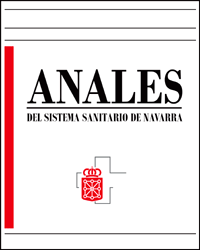Efectividad de los antivirales de acción directa de segunda generación en el tratamiento de la hepatitis C crónica
DOI:
https://doi.org/10.23938/ASSN.0006Palabras clave:
Hepatitis C crónica. VIH. Agentes antivirales. Efectividad terapéutica. Práctica clínica.Resumen
Fundamento. Los antivirales de acción directa de segunda generación (AAD) han demostrado porcentajes elevados de respuesta viral sostenida (RVS) en el tratamiento de la hepatitis C crónica en ensayos clínicos. Este estudio tiene como objetivo estimar la efectividad de los AAD en el tratamiento de esta enfermedad.
Material y métodos. Se estudiaron pacientes monoinfectados por el virus de la hepatitis C (VHC) y coinfectados por VHC y virus de la inmunodeficiencia humana (VIH) que iniciaron tratamientos libres de interferón con AAD durante 2015. La RVS se definió como una carga viral indetectable a las 12 semanas de finalizar el tratamiento, y fue el indicador principal de efectividad.
Resultados. Se incluyeron 293 pacientes, 52 (17,7%) coinfectados por VIH. Los genotipos VHC más prevalentes fueron el 1b en monoinfectados (41,5%) y 1a en coinfectados (40,4%). La proporción de cirróticos fue superior en la población coinfectada (69,2% vs 41,1%; p<0,0001), en su mayoría Child-Pugh A. La cifra global de RVS fue del 96,9% (284/293) en un análisis por intención de tratar (IC 95%: 94,9-98,9%), siendo 4 los pacientes con fracaso virológico. Tanto pacientes naïve como pretratados tuvieron RVS superior al 95%, y en la mayoría de subgrupos establecidos según la presencia o no de cirrosis, la coinfección VIH y el genotipo, la efectividad se situó próxima o por encima del 90%.
Conclusiones. Los AAD presentan una efectividad elevada, igual o superior a la descrita en los ensayos clínicos, e incluso en subpoblaciones difíciles de tratar.
Descargas
Citas
LINGALA S, GHANY MG. Natural history of hepatitis C. Gastroenterol Clin North Am 2015; 44: 717-734.
EL-SERAG HB. Epidemiology of viral hepatitis and hepatocellular carcinoma. Gastroenterology 2012; 142: 1264-1273 e1.
ASCHER NL, LAKE JR, EMOND J, ROBERTS J. Liver transplantation for hepatitis C virus-related cirrhosis. Hepatology 1994; 20: 24s-27s.
Ministerio de Sanidad, Servicio Sociales e Igualdad. Plan estratégico para el abordaje de la Hepatitis C en el Sistema Nacional de Salud: Ministerio de Sanidad, Servicio Sociales e Igualdad, 21 de Mayo de 2015. http://www.msssi.gob.es/ciudadanos/enfLesiones/enfTransmisibles/docs/plan_estrategico_hepatitis_C.pdf
GARCIA-FULGUEIRAS A, GARCÍA-PINA R, MORANT C, DE LARREA-BAZ NF, ALVAREZ E. Burden of disease related to hepatitis C and hepatitis B in Spain: a methodological challenge of an unfolding health problem. J Viral Hepatitis 2011; 18: e453-e460.
SMITH DB, BUKH J, KUIKEN C, MUERHOFF AS, RICE CM, STAPLETON JT et al. Expanded classification of hepatitis C virus into 7 genotypes and 67 subtypes: updated criteria and genotype assignment web resource. Hepatology 2014; 59: 318-327.
GOOSSENS N, NEGRO F. Is genotype 3 of the hepatitis C virus the new villain? Hepatology 2014; 59: 2403-2412.
EASL Recommendations on treatment of hepatitis C 2015. J Hepatol 2015; 63: 199-236.
FRIED MW, SHIFFMAN ML, REDDY KR, SMITH C, MARINOS G, GONCALES JR FL, et al. Peginterferon alfa-2a plus ribavirin for chronic hepatitis C infection. N Eng J Med 2002; 347: 975-982.
POORDAD F, MCCONE JR J, BACON BR, BRUNO S, MANNS MP, SULKOWSKI MS et al. Boceprevir for untreated chronic HCV genotype 1 infection. N Engl J Med 2011; 364: 1195-1206.
JACOBSON IM, MCHUTCHINSON JG, DUSHEIKO G, DI BISCEGLIE AM, REDDY KR, BZOWEJ NH et al. Telaprevir for previously untreated chronic hepatitis C virus infection. N Engl J Med 2011; 364: 2405-2416.
HEZODE C, FONTAINE H, DORIVAL C, LARREY D, ZOULIM F, CANVA V et al. Triple therapy in treatment-experienced patients with HCV-cirrhosis in a multicentre cohort of the French Early Access Programme (ANRS CO20-CUPIC) - NCT01514890. J Hepatol 2013; 59: 434-441.
PAWLOTSKY JM. New hepatitis C therapies: the toolbox, strategies, and challenges. Gastroenterology 2014; 146: 1176-1192.
BEDOSSA P, POYNARD T. An algorithm for the grading of activity in chronic hepatitis C. The METAVIR Cooperative Study Group. Hepatology 1996; 24: 289-293.
CHILD CG, TURCOTTE JG. Surgery and portal hypertension. Major Probl Clin Surg 1964; 1: 1-85.
PRICE JC, MURPHY RC, SHVACHKO VA, PAULY MP, MANOS MM. Effectiveness of telaprevir and boceprevir triple therapy for patients with hepatitis C virus infection in a large integrated care setting. Dig Dis Sci 2014; 59: 3043-3052.
AFDHAL N, REDDY KR, NELSON DR, LAWITZ E, GORDON SC, SCHIFF E et al. Ledipasvir and sofosbuvir for previously treated HCV genotype 1 infection. N Engl J Med 2014; 370: 1483-1493.
FELD JJ, KOWDLEY KV, COAKLEY E, SIGAL S, NELSON DR, CRAWFORD D et al. Treatment of HCV with ABT-450/r-ombitasvir and dasabuvir with ribavirin. N Engl J Med 2014; 370: 1594-1603.
NELSON DR, COOPER JN, LALEZARI JP, LAWITZ E, POCKROS PJ, GITLIN N et al. All-oral 12-week treatment with daclatasvir plus sofosbuvir in patients with hepatitis C virus genotype 3 infection: ALLY-3 phase III study. Hepatology 2015; 61: 1127-1135.
POORDAD F, HEZODE C, TRINH R, KOWDLEY KV, ZEUZEM S, AGARWAL K et al. ABT-450/r-ombitasvir and dasabuvir with ribavirin for hepatitis C with cirrhosis. N Engl J Med 2014; 370: 1973-1982.
FLISIAK R, JANCZEWSKA E, WAWRZYNOWICZ-SYCZEWSKA M, JAROSZEWICZ J, ZAREBSKA-MICHALUK D, NAZZAL K et al. Real-world effectiveness and safety of ombitasvir/paritaprevir/ritonavir +/- dasabuvir +/- ribavirin in hepatitis C: AMBER study. Aliment Pharmacol Ther 2016; 44: 946-956.
YOUNOSSI ZM, PARK H, GORDON SC, FERGUSON JR, AHMED A, DIETERICH D et al. Real-world outcomes of ledipasvir/sofosbuvir in treatment-naive patients with hepatitis C. Am J Manag Care 2016; 22: Sp205-211.
PANG JX, ZIMMER S, NIU S, CROTTY P, TRACEY J, PRADHAN F et al. Liver stiffness by transient elastography predicts liver-related complications and mortality in patients with chronic liver disease. PLoS One 2014; 9: e95776.
LEROY V, ANGUS P, BRONOWICKI JP, DORE GJ, HEZODE C, PIANKO S et al. Daclatasvir, sofosbuvir, and ribavirin for hepatitis C virus genotype 3 and advanced liver disease: A randomized phase III study (ALLY-3+). Hepatology 2016; 63: 1430-1441.
STARK K, SCHREIER E, MULLER R, WIRTH D, DRIESEL G, BIENZLE U. Prevalence and determinants of anti-HCV seropositivity and of HCV genotype among intravenous drug users in Berlin. Scand J Infect Dis 1995; 27: 331-337.
CURRY MP, BACON B, DIETERICH D, FLAMM SL, GUEST L, KOWDLEY KV et al. Effectiveness of 8 or 12 week LDV/SOF in treatment-naïve patients with non-cirrhotic, genotype 1 hepatitis C: real-world experience from the Trio network. Presented at: 66th Annual Meeting of the American Association for the Study of Liver Diseases; November 13-17, 2015; San Francisco, CA.
SHIRATORI Y, IMAZEKI F, MORIYAMA M, YANO M, ARAKAWA Y, YOKOSUKA O et al. Histologic improvement of fibrosis in patients with hepatitis C who have sustained response to interferon therapy. Ann Intern Med 2000; 132: 517-524.
BRUNO S, CROSIGNANI A, FACCIOTTO C, ROSSI S, ROFFI L, REDAELLI A et al. Sustained virologic response prevents the development of esophageal varices in compensated, Child-Pugh class A hepatitis C virus-induced cirrhosis. A 12-year prospective follow-up study. Hepatology 2010; 51: 2069-2076.
CARDOSO AC, MOUCARI R, FIGUEIREDO-MENDES C, RIPAULT MP, GIUILY N, CASTELNAU C et al. Impact of peginterferon and ribavirin therapy on hepatocellular carcinoma: incidence and survival in hepatitis C patients with advanced fibrosis. J Hepatol 2010; 52: 652-657.
VELDT BJ, HEATHCOTE EJ, WEDEMEYER H, REICHEN J, HOFMANN WP, ZEUZEM S et al. Sustained virologic response and clinical outcomes in patients with chronic hepatitis C and advanced fibrosis. Ann Intern Med 2007; 147: 677-684.
Publicado
Cómo citar
Número
Sección
Licencia
Derechos de autor 2017 Anales del Sistema Sanitario de Navarra

Esta obra está bajo una licencia internacional Creative Commons Atribución-CompartirIgual 4.0.
La revista Anales del Sistema Sanitario de Navarra es publicada por el Departamento de Salud del Gobierno de Navarra (España), quien conserva los derechos patrimoniales (copyright ) sobre el artículo publicado y favorece y permite la difusión del mismo bajo licencia Creative Commons Reconocimiento-CompartirIgual 4.0 Internacional (CC BY-SA 4.0). Esta licencia permite copiar, usar, difundir, transmitir y exponer públicamente el artículo, siempre que siempre que se cite la autoría y la publicación inicial en Anales del Sistema Sanitario de Navarra, y se distinga la existencia de esta licencia de uso.








